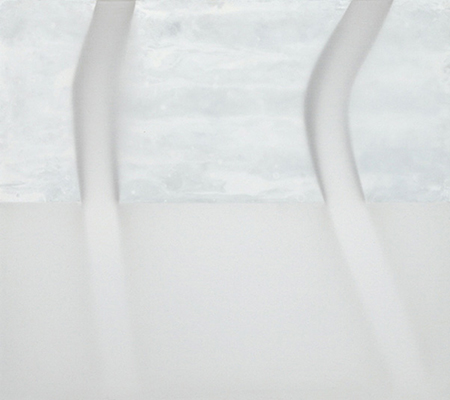
Continuing through December 6, 2014
One of the arguments made against traditional painting in our ADHD society is its fixity, which can suggest a certain inflexibility of mind, ... yes, paintings in general do not move or change. Udo Nöger’s paintings, which appear at first glance to be gestural Abstract Expressionism transmuted to a subtle, luminous palette of pale silvery grays, whites and off-whites, change as the viewer moves in and out or changes the angle of view, as well as the level and quality of light falling on and reflected back from the works. The scumbled surfaces and tubular forms (which look airbrushed, but are not) change in sharpness (and thus implied depth) and even color. The wall color may be visible, and possibly also the floor; it’s difficult to decipher how these works operate.
The method, as I understand it, comes from Noger’s layering of painted and cut canvas behind a semi-transparent scrim, probably of polyester (which became a painting surface a decade ago). About 2-1/2 inches deep, in simple white frames, these are atmospheric shadow boxes. With their abstract illusionism perfectly calibrated, they’re spatially ambiguous. At the same time, they seem to radiate light from within: the light and space environments of James Turrell come to mind, and certain 19th century Luminist landscapes, but also, with their close color harmonies and wavering forms, the breathing still lifes of Morandi. "Innen (Indoor)," "Gleiches (The Same)," "Gleiche Farbe Weiss (Same Color White)," "Gewicht des Lichtes (Weight of the Light)" and "Zeitlos (Timeless)" show Noger to be, to quote a favorite Borgesism, one of a select community: a mystic without faith.
